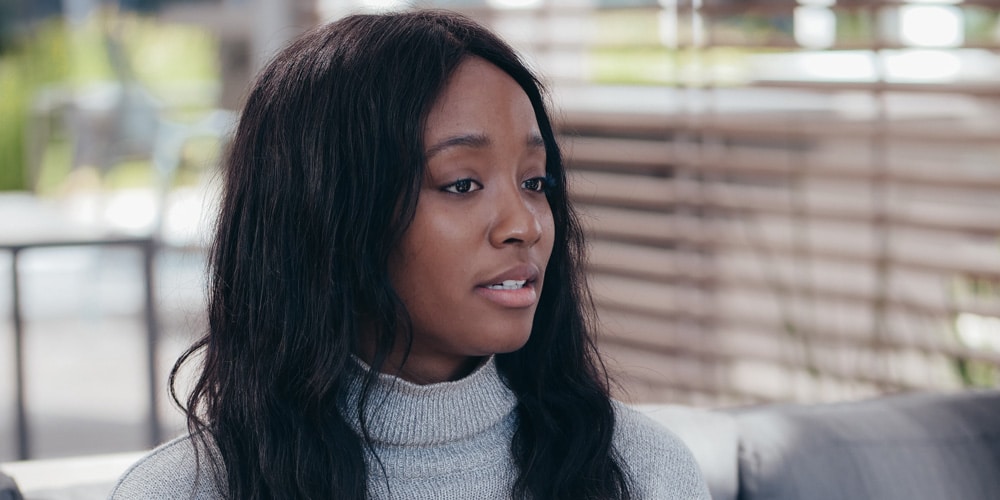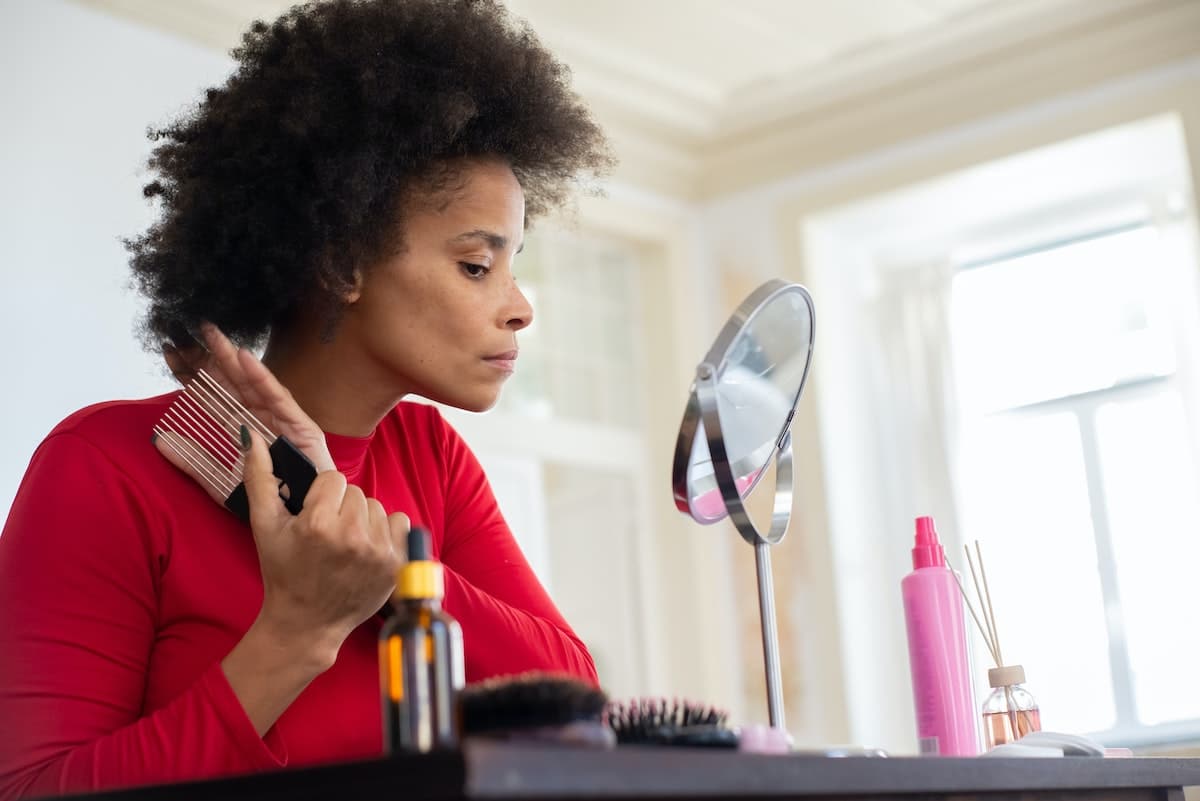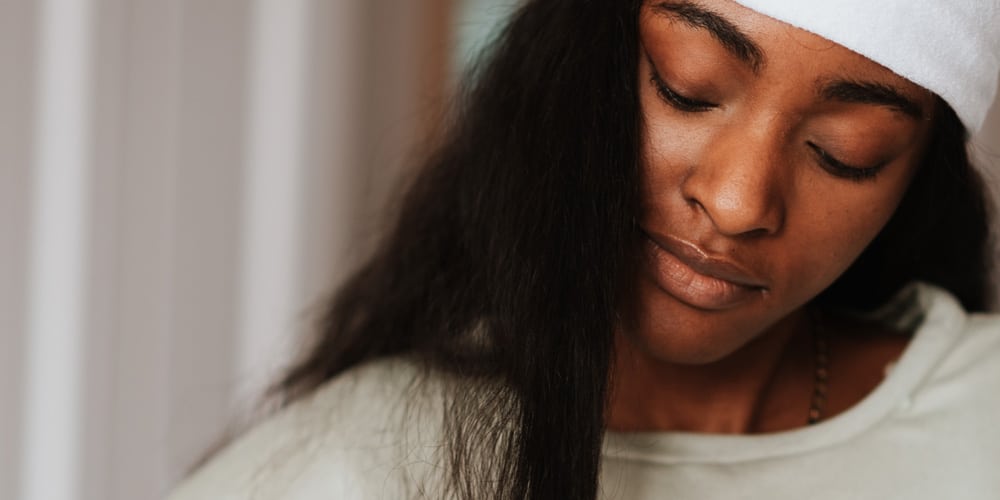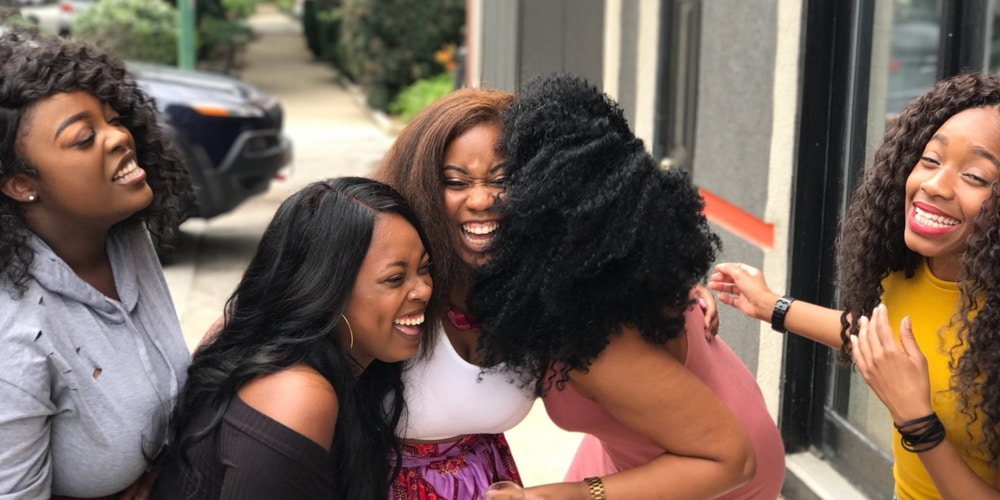For many of us with frizzy hair, having relaxed hair has a number of advantages over natural Afro hair, which is reputed to be much harder to maintain on a daily basis, even if this isn't necessarily the case.
If you like your hair straight, straightening or straightening will give you the effect you want. But be careful! These two techniques are not without risks for both scalp and hair.
That's why, whether you've already taken the plunge or you're still hesitating to sacrifice your curls, our Clauderer specialists tell you everything you need to know in order to take good care of your frizzy hair once it has been relaxed. Taking good care of relaxed hair means understanding what happens when the hair is relaxed.
What exactly is straightening?
At the start keratin Hair is made up of long vertical chains of proteins, linked to each other by sulphur atoms which form real welding bridges (di-sulphide bridges), joining the protein chains together and keeping the keratin in its initial curl. The straightening process acts on these sulphur welds: using a highly alkaline (or basic) product, i.e. one with a pH above 7, the aim being to open up the hair scales, allowing the keratin to be modified in depth), the natural organisation of the hair is artificially destroyed, by breaking the double sulphur bridges and replacing them with a single bridge (sulphide bridge).
With its backbone removed, keratin no longer offers resistance, and curls can be softened until the desired stiffness is achieved. A prolonged rinse and a neutralising shampoo then eliminate the alkaline residue and put an end to the stiffening process.
A clear distinction must be made between smoothing (semi-permanent) from relaxing (irreversible). Unlike straightening, smoothing does not permanently alter the original structure of frizzy or curly hair. Straightening involves straightening frizzy, curly or curly hair. Certain ingredients, such as formaldehyde in straightening solutions and soda in straightening formulas, can damage the hair's internal structure.
2 types of straightening :
- The gentle straightening is suitable for curly or medium-curly hair. It uses tiolée. The product acts on the surface of the hair to change its appearance. After between 3 and 6 months, depending on the density of the hair, the product wears off and the hair regains its original elasticity and texture.
- The strong straightening is reserved for very curly to frizzy hair. It uses the alkaline which, as we have seen, consists of opening the hair scales so as to reach deep into the hair fibre and artificially break up the keratin molecules. The hair is then given a stiff texture, made definitive by a chemical action.
Warning: the two types of straightening are not compatible. Hair that has been straightened with a thiol product cannot be straightened with an alkaline product and vice versa. You should wait until all traces of the product used have disappeared before changing techniques. For all these reasons, we strongly recommend that you limit thiolol straightening to three times a year and wait six weeks between two alkaline straightenings.
Before taking the plunge :
- Choose the right product for your hair type, do a touch test
- Respecting break times
- Do not straighten your hair alone at home (oversights or clumsiness can lead to scalp burns and localised breakage).
- Follow a precise method when applying the product, always finishing with the nape of the neck and the temples, areas where hair is particularly fragile.
- Do not straighten all the lengths each time, but only the new growth.
Consequences of straightening
Firstly, the hair is much more fragile because, to soften them, the relaxer had to start by "boning" their keratin.
Then the scalp and hair become far too dry because the water molecules that normally attach themselves to proteins no longer have anything to cling to, resulting in dandruff and irritation all over the scalp, dry hair and brittle split ends. Done too frequently, straightening damages the hair's natural protection. As well as undergoing a permanent change to its structure, the hair fibre is also deprived of its natural protective oils, sebum and ceramides (ceramides are naturally present in the hair and skin; they act as a binder to hold the scales together and strengthen the hair fibre).
In the long term, and in a more insidious way, the products used for straightening can turn out to be harmful to health. This is the case with soda ash and its derivatives. As in many everyday hair care products, endocrine disruptors lurk in cosmetic formulas. A North American study has highlighted the preponderance of these chemical substances in many hair products aimed at the black beauty market:https://silentspring.org/news/hair-products-black-women-contain-mix-hazardous-ingredients.
Yet another reason to choose natural cosmetics!
Soda-free products
Even so-called 'lye-free' products are in fact derivatives of lye or potash, which are less powerful but still very aggressive on the hair. Clearly, whatever the products used (guanidine, for example), if straightening is not accompanied by a great deal of precaution during the process and intensive care afterwards, even the strongest hair will not stand the test for long.
How do I care for relaxed hair?
How should relaxed hair be cared for?
Relaxed hair is often dry and dull, especially if the technique is used too frequently. It breaks at several points along its length, mainly at the curl-straighten junction, but also at the base of the hair, which reduces the overall volume of the hair. The scalp is not spared : the scalp is also too dry and often irritated. Too long a leave-in can also cause scalp burns. In other words, the hair's lost defences need to be rebuilt.
However, having beautiful relaxed hair is entirely possible, so don't despair! Here are the essential points to remember to properly care for and repair your relaxed hair and make the most of its beauty potential.
The three needs of relaxed hair: hydration, nutrition and proteins.
After straightening, hair often becomes dull, brittle and more fragile. It is therefore important to restoring hair's ecology whose balance has been particularly upset.
This is an essential difference, and one that is unfortunately little known: hydration, proteins and nutrition are three distinct needs of our hair. These are the three pillars that will ensure the good health of our hair. Hair care products designed to provide in-depth care and maintenance will be much more effective once we have identified our hair's needs.
1. HYDRATION
Hydration is a fundamental need. Most relaxed hair is dehydrated: it needs water. A moisturising mask will often have a miraculous effect on hair that has never been used to being "quenched". We need a moisturising treatment if :
- our hair is dry,
- they look like straw
- they break
For moisturise effectively, there is only one rule: you must seal in that moisture. Seal hydration means trap water in the hair fibre. To do this, you need to use a greasy substance (vegetable oil or butter). The better care to moisturise relaxed hair are the following rich in vitamins and acids essential fats (omega 3 and 6) like jojoba oil or olive oil, which are light oils; for the same reasons, shea butter is also a high-quality moisturiser.
These care and styling products must moisturise without greasing in order to repair the damaged cuticle while providing both proteins and lipids. See the following Clauderer products Balm No. 56, Cream N° 25 or Cream No. 26R)
Warning: moisturising does not mean greasing, systematically or with anything. Some products that are too greasy prevent the scalp from breathing, which can lead to more dandruff and irritation, and sometimes even suffocate the roots. Animal or mineral fats should therefore be avoided. In particular:
- Vaselines: They weigh hair down without nourishing it, over-grease and clog the pores of the scalp.
- Lanolin: derived from cholesterol, it promotes irritation and the secretion of the DHT hormone responsible for hormonal hair loss.
- Too much glycerine: if its presence exceeds 5% of the total content: attracting moisture itself, it absorbs and retains the moisture needed by the hair, making it even drier.
The essentials for moisturising relaxed hair :
- Water/Liquid: a spray bottle filled with mineral water
- Hair milk: to deeply moisturise the hair.
- A hair cream (N° 25 or N° 26R): to nourish the hair.
- A vegetable oil or butter: to seal in moisture
Here are 2 methods depending on the type of hair:
1 - LOC method: For Liquid, Oil and Cream. It consists of applying in order :
- Mineral water
- followed by a light cream (N° 25 or N° 26R) or hair milk (N° 1R or N° 3 or N° 3R)
- Finally, a small amount of vegetable oil (your choice of olive, avocado, argan, jojoba, etc.).
Particularly recommended for thick, dense hair that needs a hyper-concentrated treatment that really penetrates to the heart of the hair fibre.
2 - LCO method: For Liquid, Cream and Oil. The products are applied in this order:
- Mineral water
- then a vegetable oil (or butter) of your choice (see above)
- and finally, a light cream or hair milk
This method is recommended for fine hair that cannot tolerate products that are too rich, which could weigh it down and saturate it unnecessarily.
2. PROTEINS
The proteins needed to revitalise hair damaged or sensitised by straightening can be found in keratin-based treatments. Proteins improve hair elasticity and make it more supple.
The way our hair reacts to products, and more specifically proteins, can vary from one individual to another. In fact, some hair may react very well to silk proteins and not tolerate wheat germ proteins, for example, without us knowing why.
If our hair remains too dry, regardless of the treatments and care we use, it's probably because we have too much protein. In this case, protein intake should be less frequent than hydration and nutrition. Instead, we'll opt for a one-off treatment in the form of a cure. On the other hand, in the case of very damaged hair (with open scales leading to high porosity), a protein treatment is absolutely essential for regular maintenance.
Many hair care products contain one or more active protein ingredients, with different dosages depending on the product and its use. This may be a milk or lotion, a conditioner, a shampoo, a spray or a hair mask. This type of product is often labelled "repairing" or "restructuring", for example (Clauderer Healing Balm No. 56). The right frequency for a mask? Once a week or every 10 days, depending on the condition of the keratin. But it must be done regularly.
3. NUTRITION
The need for nutrition is the need for fats. We need nutrition if our hair :
- are dull,
- lack shine,
- or break easily (split ends).
If this is the case, plant oils and butters will meet the needs of your undernourished lengths. Different types of oils and butters are available: oils that are more or less dry, more or less heavy: coconut, avocado, jojoba, grapeseed and vegetable butters: shea, mango, cocoa etc. In this case, you can ..:
- Use oil baths before shampooing: spread the oil over the lengths (do not apply to the scalp as this will clog the pores and prevent the scalp from breathing) and leave overnight. To use 1 time per month maximum so as not to saturate the fibre!
- Use conditioners that must be rinsed off.
If all hair needs hydration and proteins, their need for nutrition is more variable. In fact, if hair is properly moisturised and receives a sufficient supply of proteins, then additional nutritive care (oil, vegetable butter) will not necessarily be necessary "in high doses". As the saying goes, "the best is the enemy of the good". Think about it before you saturate your lengths thinking you're doing the right thing!
The needs of relaxed hair are different from those of natural frizzy or curly hair, and you need to adopt new habits to look after your "new hair". Relaxed hair's need for nutrition is different: its scales are too open to absorb nutrients and, above all, keep at the heart of the fibre the nutrients provided by an excessively rich fat. That's why nutrition is good, but nutrition in moderation A monthly routine is quite sufficient. Especially if your hydration and protein needs are met.
What about the scalp?
All too often, the scalp is neglected, even though it is subjected to the action of aggressive chemicals during straightening, even though it is recommended that stripping products should only be applied at a reasonable distance from the scalp. To avoid itching or redness, apply a Milk directly on the scalp. Complete your hair routine with a Crème lavante rather than a simple shampoo.
Think about massage regularly your scalp to stimulate sebum production. It's a natural and pleasant way to restore the lipid film. Why not use a lotion or, better still, a serum regrowth activator?
Plus, our advice on how to look after your hair every day:
- Wait a fortnight after straightening if you want to colour your hair
- Use straighteners and hairdryers sparingly
- Avoid hairstyles that are too tight (braids, buns, etc.), which can increase the risk of breakage and traction alopecia.
- Avoid products containing silicone, sulphate or collagen (a very aggressive ingredient that can eventually fade the effects of straightening).
- Use a wide-tooth comb when detangling and styling and pay particular attention to the curly-curly junction after regrowth: this is a highly sensitive breaking point.
- Cut the last few centimetres of your hair regularly, as this is the oldest part of the hair and therefore the most likely to be weakened (split ends, dehydration).
- Choosing the right shampoo. Choose gentle shampoos no industrial sulphates (Attention: certain sulphates are absolutely harmless and are present in organic cosmetics, certified by recognised organisations such as ECOCERT. Once again, read the labels, but not just any old way!)
- Much better for your hair, use a non-foaming cleansing cream (Cream N° 25 or Cream 26R) and don't wash your hair too often. Attention : cleansing cream means cream containing cleaning agents.
- In other words, when you are advised to apply the co-washing technique by replacing your over-lathering shampoo with a conditioner (which, by definition, doesn't lather), you've got it all wrong: a conditioner doesn't wash. The sole purpose of a conditioner is to help you detangle your lengths. It will never wash the hair, that's not its job. That's why users often complain that their hair doesn't wash properly with this method. We regularly see this when we examine the hair at the time of diagnosis. However, if you use too many oils on your lengths, this solution is not for you, as you will have the impression that your hair and scalp are not properly cleansed.
- Mousse often means shampoos that are poorly adapted to the hair (and often formulated with lots of chemicals) and particularly poorly adapted to Afro hair, which is much more sensitive than other hair types. The more the shampoo lathers, the more powerful the cleansing agents are and remove the hair's natural protection, which is virtually non-existent in straightened frizzy hair. In other words, the more natural or organic a shampoo is, the less it lathers.
As well as treating your relaxed hair locally, don't forget that "beauty also comes from within"!
That's why it's important to adopt a a healthy lifestyle. This inevitably involves adopting as healthy a lifestyle as possible: drinking plenty of water, filling up on vegetables, fruit and proteins to provide all the essential nutrients your hair needs. Forget the "strict" diets that hair hates. The emphasis is on essential fatty acids such as Omega 3, which keep hair shiny and healthy. It's also important to free yourself from stress, which can damage your health and that of your hair. Beware of certain medicines, as some treatments have side effects and damage the hair structure.
Summer brings with it the urge to expose our skin to the sun. It's worth remembering that the sun brings its share of benefits, including the production of vitamin D, a component of precious keratin. However, the sun can have harmful effects, especially on relaxed hair, by weakening and damaging the hair fibre.
Before heading off to the sun, the 3 summer essentials to pack :
- a small spray bottle for daily moisturising,
- a cream cleanser to remove salt and sand residues,
- a repairing mask to strengthen hair against external damage
This ritual will help your relaxed hair come back stronger, especially if you protect it with a hat or scarf during prolonged exposure to the sun.
In conclusion, if you want to keep your hair looking good after straightening, you have to be prepared to spend a little time on it.
The watchword is care, care and more care ! Your new hairstyle is worth it!
Relaxing and hair loss
Many women complain that their hair hasn't grown since that they straighten their hair. And yet, in principle, the products used to straighten hair do not attack the roots. It's just that the volume of broken hair is often so great that it looks like it's been straightened.a feeling of decline or stagnation always at the same length. Once broken, hair cannot be repaired. However, you can help it to grow faster and regain volume.
The treatment consists of feedingwhile stimulating root activity. Certain plant-based active ingredients, specifically designed for hair regrowth, give young hair strength and help it to grow back. prepare you to better withstand straightening (See the action of the Serum Activ'Croissance).
The microscope test






